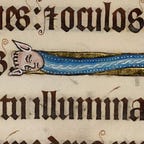Medieval Medicine: The Four Humors Part 1, The Basics
While certain aspects of medieval medicine are surprisingly scientifically accurate, one of the main medical theories of the European middle ages most certainly is not. This medical theory is called humorism or humoral theory. Humoral theory is the theory that the human body is made up of and controlled by the four bodily fluids known as the humors. The four humors were believed to control a person’s health, the way their body looked, and even their personality/temperament. The four humors are:
- Blood
- Phlegm
- Black Bile
- Yellow Bile
Humorism originated in Ancient Greece. Classical figures such as Hippocrates and Galen wrote down their own humoral theories and their texts were the foundation for medieval humorism. Galen’s theory not only consisted of the four humors making up the human body but that each of the humors had a corresponding element that made up the humor:
- Blood/Air
- Phlegm/Water
- Black Bile/Earth
- Yellow Bile/Fire
Each of the four humors was also associated with a certain degree of wetness and heat:
- Blood was hot and wet.
- Phlegm was cold and wet.
- Black bile was cold and dry.
- Yellow bile was hot and dry.
Fire is hot and dry so yellow bile is hot and dry, water is cold and wet so phlegm is cold and wet, etc. Because dryness was considered the absence of moisture and coldness was considered the absence of heat, dryness and coldness were considered to be negative qualities because they lacked the positive traits heat and moisture. Medieval people even went as far as to consider these negative qualities as harmful or even outright evil. Black bile, whose traits are cold and dry, was considered to be deadly if humans had too much of it.
The four humors were not only important in medieval European medicine. The 9th century Middle Persian text, Wizīdagīhā ī Zādspram, documented a medieval Iranian medical theory about the four humors. In the Wizīdagīhā ī Zādspram the humors have the same wet and dry properties found in ancient Greek and medieval European texts. However, there are two main differences in this text. One difference is that yellow bile is called red bile and each humor has properties associated with taste and color:
- Blood is red and sweet.
- Phlegm is white and salty.
- Black bile is black and sour.
- Red bile is red and bitter.
In medieval Europe, the four humors also corresponded to a body organ:
- Blood was associated with the head or liver (depending on the source).
- Phlegm was associated with the brain and lungs.
- Black bile was associated with the gall bladder.
- Yellow bile was associated with the spleen.
Medieval humoral theory believed that all four humors were combined to make semen. I understand where the logic for this came from. Because humors made up the human body, it’s no wonder people thought the source of new humans came from all the other humors!
Print Sources:
Green, Monica Helen. The Trotula: An English Translation of the Medieval Compendium of Women’s Medicine. PENN, University of Pennsylvania Press, 2002.
Mount, Toni. Medieval Medicine: Its Mysteries and Science. Amberley, 2016.
Pollington, Stephen. Leechcraft: Early English Charms, Plant Lore, and Healing. Anglo-Saxon Books, 2008.
Pouchelle, Marie-Christine. The Body and Surgery in the Middle Ages. Rutgers University Press, 1990.
Web Sources:
https://www.bbc.co.uk/bitesize/guides/zyscng8/revision/1
https://www.britannica.com/science/humor-ancient-physiology
https://www.iranicaonline.org/articles/health-in-persia-i
https://www.medicinenet.com/humorism/definition.htm
https://public.wsu.edu/~hanly/chaucer/coursematerials/humours.html
Google Books Sources:
Lewis-Anthony, Justin (2008). Circles of Thorns: Hieronymus Bosch and Being Human. Bloomsbury. p. 70. ISBN 9781906286217. https://books.google.com/books?id=7WD45AoYO0EC&q=adulthood#v=snippet&q=adulthood&f=false
